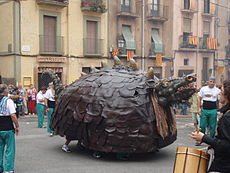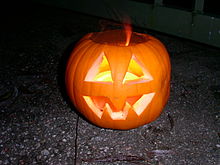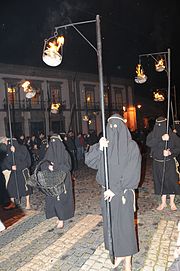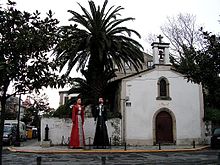- Cuco
-
The Coco (or Cuco; Coca; Cuca; Cucuy) is a mythical ghost-monster; equivalent to the boogeyman, found in many Hispanic and Lusophone countries. He can also be considered a Hispanic version of a bugbear,[1] as it is a commonly used figure of speech representing an irrational or exaggerated fear. The coco is a male being while coca, is the female version of the mythical monster although it is not possible to distinguish one from the other as both are the representation of the same being.
Contents
Names and etymology
The myth of the coco originated in Portugal and Galicia. According to the Real Academia Española the word "coco" derives from the Portuguese language, and referred to a ghost with a pumpkin head [2](in that "coco", from which derives the word coconut, is analogous to a pumpkin or calabaza). The word coco is used in coloquial speech to mean the human head in Portuguese and Spanish.[3] Coco also means skull.[4] The word "cocuruto" in Portuguese means the crown of the head and the highest place.[5] The name coco could have its origins in the old Celtic word *kokk– meaning ‘red’.[6] Either the pumpkin or the dragon are related with fire which is of the same colour. Koko in Basque means mask.[7]
In Northern New Mexico and Southern Colorado, where there is a large Hispanic population, el cuco is referred to with its anglicized name, the Coco Man.[8] But in Brazilian folklore, the typical monster sung in children rhymes is Cuca, pictured as a female humanoid alligator from Portuguese coca,[9] a dragon.
Legend
The name of the Cuco is widely used by parents in Spain and Latin America when children disobey their parents, do not want to go to sleep, do not want to eat, or go to prohibited places and like to wander. It is not the way the cuco looks but what he does that scares most. The cuco is a child eater and a kidnapper, it immediately devours the child and leaves no trace of her or it takes the child away to a place of no return, but it only does this to disobedient children. The coca is on the look out for child's misbehavior on the top of the roof, the coco takes the shape of any dark shadow and stays watching. They are attracted by a child's disobedience.[10] They represent the opposite of the guardian angel and are frequently compared to the devil. Others see the coco as the representation of the deceased of the local community.[11]
Parents sing lullabies or tell rhymes to the children warning them that if they don't sleep, el Coco will come and get them.
The oldest known rhyme, which originated in the 17th century, is in the "Auto de los desposorios de la Virgen" by Juan Caxés.
The rhyme has evolved over the years, but still retains its original meaning:
“ Duérmete niño, duérmete ya... Que viene el Coco y te comerá.
” Which translates as:
“ Sleep child, sleep now... Or else the Coco will come and eat you.
” During the Portuguese and Spanish colonization of Latin America, the legend of the Cuco was spread to countries such as Mexico, Argentina and Chile. In the Mexican-American community the creature is known as "El cucuy".
Physical representations
Cucafera during the "Fiesta Mayor de Santa Tecla" in Tarragona, Spain
There is no general description of the cucuy, as far as facial or body descriptions, but it is stated that this shapeshifting being is extremely horrible to look at. The coco is variously described as a shapeless figure, sometimes a hairy monster, that hides in closets or under beds and eats children that misbehave when they are told to go to bed.
Mythical animals
Coca is a female dragon that in medieval times, in the Iberian Peninsula, used to take part in different celebrations. In Portugal one still survives in Monção and she fights in some sort of medieval tournament with saint George during the Corpus Christi celebrations. She is called "Santa Coca" (Saint Coca) or "Coca rabixa" (Tailed Coca) and if she defeats Saint George, by scaring the horse, there will be a bad year for the crops and famine, if the horse and Saint George win by cutting off one of her ears with earring and her tongue, the crops will be fertile.[12][13] Oddly enough the people cheer for Saint Coca. In Galicia there are still two dragon cocas, one in Betanzos the other in Redondela.[14] The legend says that the dragon arrived from the sea and was devouring the young women and was killed in combat by the young men of the city. In Monção, the legend says, she lives in rio Minho; in Redondela she lives in the Ria of Vigo[15]
The oldest reference to Coca is in the book "Livro 3 de Doações de D. Afonso III" from the year of 1274, where it is referred as a big fish that appears on the shore:[16]
-
- "And if by chance any whale or sperm whale or mermaid or coca or dolphin or Musaranha or other large fish that resembles some of these die in Sesimbra or Silves or elsewhere...[]"
In Catalonia the "Cuca fera de Tortosa" was first documented in 1457. It is a zoomorphic figure, looks like a tortoise with a horned spine, it has dragon claws and a dragon head.[17][18] The legend says she had to dine every night on three cats and three children. The legend of the Coca can be compared to the one of Peluda or Tarrasque.
In Brazil the cuco appears as a female alligator called 'cuca'. Cuca appears as the villain in some children books by Monteiro Lobato. Artists illustrating these books depicted the cuca as an anthropomorphic alligator. She is an allusion to coca the dragon, from the folklore of Portugal and Galicia
Heads
 The sailors of Vasco da Gama called the fruit of the Polynesian palm tree, "coco". The word "coconut" is derived from their naming.
The sailors of Vasco da Gama called the fruit of the Polynesian palm tree, "coco". The word "coconut" is derived from their naming.
Traditionally in Portugal, however, the coco, is represented by an iron pan with holes to represent a face with a light in the inside or by a carved vegetable lantern made from a pumpkin with two eyes and a mouth, that is left in dark places with a light inside to scare people. In the Beiras, heads carved on pumpkins, called "coca", would be carried, by the village boys, stuck on top of wooden stakes.
- "The same name [Coca] is given to the pumpkin perforated with the shape of a face, with a candle burning in the inside - this gives the idea of a skull on fire - that the boys on many lands of our Beira carry stuck on a stick."[19][dead link]
An analogous custom was first mentioned by Diodorus Siculus (XIII.56.5;57.3), in which Iberian warriors, after the battle of Selinunte, in 469 BC, would hang on their spears the heads of the enemies.[20] According to Rafael López Loureiro this carving representation would be a milenar tradition from the celtiberian region that spread all over the Iberian Peninsula.[21][22]
- "The autumnal and childish custom of emptying pumpkins and carving on its bark, eyes, nose and mouth looking for a sombre expression, far from being a tradition imported by a recent Americanizing cultural mimicry, is a cultural trait in ancient Iberian Peninsula."[23]
This representation would be related to the celtic cult of the severed heads in the Iberian peninsula.[24][25] According to João de Barros, the name of the "coconut" derived from "coco" and was given to the fruit by the sailors of Vasco da Gama, c.1498, because it reminded them of this mythical creature.[26][27]
- "This bark from which the pome receives its vegetable nourishment , which is through its stem, has an acute way, which wants to resemble a nose placed between two round eyes, from where it throws the sprout, when it wants to be born; by reason of such figure, it was called by our [men] coco, name imposed by the women on anything they want to put fear to the children, this name thus remained, as no one knows another."[28]
Rafael Bluteau (1712), defines that the coco and coca were thought to look like skulls, in Portugal:
- "Coco or Coca. We make use of these words to frighten children, because the inner shell of the Coco has on its outside surface three holes giving it the appearance of a skull"[29]
Hooded cloak
In Portugal coca is a name for the hooded cloak. In Portimão during the holy week celebrations, in the “procissão dos Passos" (sp: Procesión de los Pasos), a procession organized by the Catholic brotherhoods, the herald, a man dressed with a black hooded cloak that covered his face and had three holes for the eyes and mouth, lead the procession and announced the death of Christ was either named coca, farnicoco,( farricunco, farricoco from latin far,farris[30] and coco) or death. The name coca was given to the cloak and to the man who wore the cloak.[31]
In 1498, the portuguese king Manuel I gives permission to the catholic brotherhood of the Misericórdia to every year on All Saints' Day collect the bones and remains from the gallows of those that had been condemned to death and put them in a grave.[32] The brotherhood in a procession , known as Procissão dos Ossos, were followed by the farricocos who carried the tombs and collected the bones.[33][34][35] The farricoco is the bearer who carries dead corpses.[36]
Giants
Os cocos, giant representation of the coco and coca of Ribadeo known from the XIX century .
In Ribadeo two giant figures represent "el coco y la coca" that dance at the sound of drummers and Galician bagpipe players .[37][38][39]
In literature
In the last chapter of the work of Miguel de Cervantes the epitaph of Don Quijote identifies him as the scarecrow and el coco.[40]
-
- Tuvo a todo el mundo en poco,
- fue el espantajo y el coco
- del mundo, en tal coyuntura,
- que acreditó su ventura
- morir cuerdo y vivir loco
In popular culture
- Que Viene el Coco, (1799) which shows a cloaked, menacing figure, was painted by Goya.[41]
- Dominican Salsa-Merengue musician and singer Cuco Valoy makes several humorous references to the myth in some of his songs (¡ahi viene el cuco, mama!).
- In the novel Thief of Midnight, the main adversary is El Cucuy, a psychotic, power-hungry bogeyman in the form of a dead child.
- In a season 4 episode 2 of the popular children's television series Wizards of Waverly Place Cucuys are portrayed as wealthy Latino versions of a Boogey Man.
- According to social sciences professor Manuel Medrano, popular legend describes cucuy as a small humanoid with glowing red eyes that hides in closets or under the bed. 'Some lore has him as a kid who was the victim of violence ... and now he’s alive, but he’s not,' Medrano said, citing Xavier Garza’s 2004 book Creepy Creatures and other Cucuys."[42]
See also
References
- ^ The Year's Work in Modern Languages Study pg 175
- ^ Coco. REAL ACADEMIA ESPAÑOLA
- ^ A Portuguese-English dictionary pg 164
- ^ The concise dictionary of English etymology pg 91
- ^ A dictionary of the Portuguese and English languages, in two parts pg
- ^ [1]
- ^ [2]
- ^ Chicano folklore Pg 57
- ^ [3]
- ^ LA IMAGEN DEL JOVEN A TRAVÉS DE LAS FICCIONES DE TERROR Y SUS FUENTES FOLKLÓRICO-LITERARIAS. EL CASO IBEROAMERICANO
- ^ Aproximación antropológica a Castilla y León
- ^ the feast of santiago in Galicia 1956. JSTOR Folklore, vol68, n 4
- ^ Festa da Coca anima Monção. Correio da manhã
- ^ A coca de Betanzos
- ^ Festival, comedy and tragedy: the Greek origins of theatre pg 380
- ^ d'Azevedo, Pedro. Revista Lusitana.Miscelânia. Volume IV Antiga Casa Bertrand, 1896
- ^ Actes del Novè Col·loqui Internacional de Llengua i Literatura Catalanes
- ^ Forms of tradition in contemporary Spain
- ^ Beira Alta - Assembleia Distrital de Viseu, Junta de Província da Beira Alta, Arquivo Provincial (Beira Alta, Portugal), Junta Distrital de Viseu, Arquivo Distrital (Viseu, Portugal) - Beira Alta (Portugal) - 1946. Pg 296
- ^ La creencia en la ultratumba en la Hispania romana a través de sus monumentos pg 4
- ^ Samaín: A Festa das Caliveras
- ^ O Samaín é una tradizón moi estendida pola Península Ibérica
- ^ Pasado y presente de los estudios Celtas. Las calaveras de ánimas en la Península Ibérica pg 449
- ^ As caveiras de colondros e o tempo de Samaín pg 6
- ^ Las «cabezas cortadas» en la Península Ibérica
- ^ pg481
- ^ Portuguese Vocables in Asiatic Languages pgs 109-111
- ^ Barros, João de. Da Ásia de João de Barros e de Diogo do Couto: dos feitos que os portugueses fizeram no descobrimento dos mares e terras do Oriente. Década Terceira. Lisboa: Na Régia Officina Typografica, 1777-1788 (Biblioteca Nacional Digital)
- ^ Dalgado, Sebastião. Glossário luso-asiático, Volume 1 pg 291
- ^ Corpus lexicográfico da lingua galega
- ^ J. António Guerreiro Gascon.Festas e costumes de Monchique
- ^ Santa Casa da Misericórdia de Santarém
- ^ Novo diccionario portatil das linguas portugueza e ingleza pg 202
- ^ Novo Diccionario da lingua Portugueza
- ^ História Breve das Misericórdias Portuguesas pg 45
- ^ Novo diccionario portatil das linguas portugueza e ingleza
- ^ [4]
- ^ [5]
- ^ Armesto, Victoria. Galicia feudal, Volume 1
- ^ Don Quixote/Volume 2/Chapter LXXIV
- ^ [6]
- ^ El cucuy has roots deep in border folklore
Categories:- Shapeshifting
- Ghosts
- European mythology
- Medieval European legendary creatures
- Latin American folklore
- Brazilian folklore
- Portuguese legendary creatures
- Spanish legendary creatures
- Fictional witches
- Portuguese folklore
- Spanish folklore
- Mexican folklore
-
Wikimedia Foundation. 2010.







